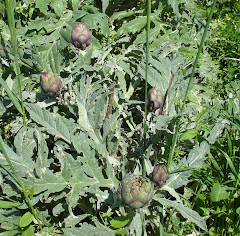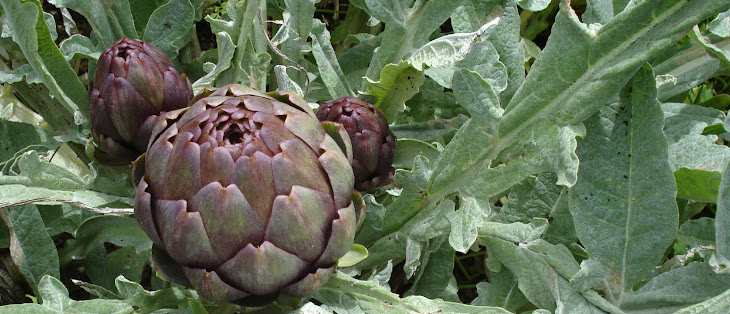Our favourite way of spending Sunday is in the garden, with friends, family or on our own, cooking and eating a long slow lunch and doing a few of the jobs that need doing - watering, harvesting, nothing too strenuous. This is what we did today.
Sundried chilli peppers and aubergines
 I threaded the ripe chilli peppers onto two strings, as I did last year, and hung them from a beam in the sunniest place in the garden. This beam is intended to support our grape vine when it grows a bit bigger, but in the meantime it's a good place to dry vegetables. The chilli peppers should take about a week to dry - some of them are quite big. We're only just finishing the ones I dried last year, so they keep well for at least a year.
I threaded the ripe chilli peppers onto two strings, as I did last year, and hung them from a beam in the sunniest place in the garden. This beam is intended to support our grape vine when it grows a bit bigger, but in the meantime it's a good place to dry vegetables. The chilli peppers should take about a week to dry - some of them are quite big. We're only just finishing the ones I dried last year, so they keep well for at least a year.
 Today I decided to try drying aubergine, something I haven't done before. I sliced an aubergine thinly, into slices about 2 mm thick, laid them out on kitchen paper and sprinkled them with salt. Twenty minutes or so later the salt had drawn out a lot of the moisture. I threaded the slices using a needle and thread, tying a knot around each one to keep them apart and hung the strings from the same beam as the chillies. A few hours of hot sun later and they were already quite dry - I expect them to be completely dry in a day or so.
Today I decided to try drying aubergine, something I haven't done before. I sliced an aubergine thinly, into slices about 2 mm thick, laid them out on kitchen paper and sprinkled them with salt. Twenty minutes or so later the salt had drawn out a lot of the moisture. I threaded the slices using a needle and thread, tying a knot around each one to keep them apart and hung the strings from the same beam as the chillies. A few hours of hot sun later and they were already quite dry - I expect them to be completely dry in a day or so.
Threading the chillies and aubergine slices takes quite some time, but it seemed a nice restful job for Sunday in the garden and I enjoyed doing it. I hope drying the aubergine works as it will be a good way to store them.

There are many Spanish people living in Gabian - in fact when you go to the shops or the market you're almost as likely to hear a conversation in Spanish as in French - so we're lucky enough to be able to buy paella rice, Spanish white beans, paella spices and so on in the little local shop just round the corner from our house. For lunch today I made a paella:
Chicken Paella
(for 4 people)
Chicken pieces (I used the large chicken legs we can buy in our local shop, poulet fermier or free-range chicken, cut into smaller pieces)
1 large courgette, roughly chopped
1 red chilli pepper, finely chopped
green beans
1 large onion, sliced
3 cloves garlic, chopped
some small pieces of chorizo
100 gm cooked white haricot-type beans (optional)
a few threads of saffron (I cheat a bit and use the sachets of Spanish spices we can buy here, which contain saffron and powdered rosemary, but I add rosemary from the garden too)
2 sprigs of rosemary
1 large cup of rice
the juice of 1 lemon
2 tomatoes, chopped
salt and pepper

Fry the chicken pieces in olive oil in a large frying pan or paella pan for about 40 minutes until cooked through. Remove from the pan. Sauté the onion and courgette until soft. Add garlic and chilli pepper for a few moments and put the chicken pieces back in the pan with the vegetables. Add the spices and the rice and stir to coat with the oil. Add water, lemon juice and chopped tomatoes - there should be about three times the volume of the rice, but you may need to add more water later if it evaporates. Add the green beans cut into short pieces. Bring to the boil and leave to simmer. Unlike risotto, paella must not be stirred. When the rice is almost cooked add the pieces of chorizo and the white beans. When it's ready put the pan on the table and let people help themselves.

I cooked this over a charcoal fire on the barbecue. It can be cooked on a wood fire or on a gas or electric hob too.
Terracotta pot update
 The haricots verts (French beans) which I sowed around the terracotta pots are growing well. A couple of weeks ago I was worried that they were only producing leaves, not flowers, and that maybe they were getting too much water! Now, though, they are flowering well and we'll be picking beans from them in a few days' time. The plants are much bigger than the previous row we sowed and watered in the conventional way - I'm sure this is due to the terracotta pot system, which really seems to work.
The haricots verts (French beans) which I sowed around the terracotta pots are growing well. A couple of weeks ago I was worried that they were only producing leaves, not flowers, and that maybe they were getting too much water! Now, though, they are flowering well and we'll be picking beans from them in a few days' time. The plants are much bigger than the previous row we sowed and watered in the conventional way - I'm sure this is due to the terracotta pot system, which really seems to work.
Ananas tomatoes
This year for the first time we've grown a variety of tomatoes called Ananas (pineapple). The fruits are very big. They're a bit mishapen but inside the flesh is deliciously sweet, mango coloured with flecks of red. It looks - and almost tastes - like a fruit salad!

 a climbing scented rose / rose grimpante parfumée
a climbing scented rose / rose grimpante parfumée


















































